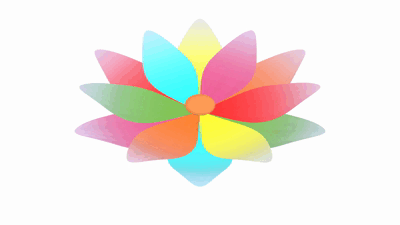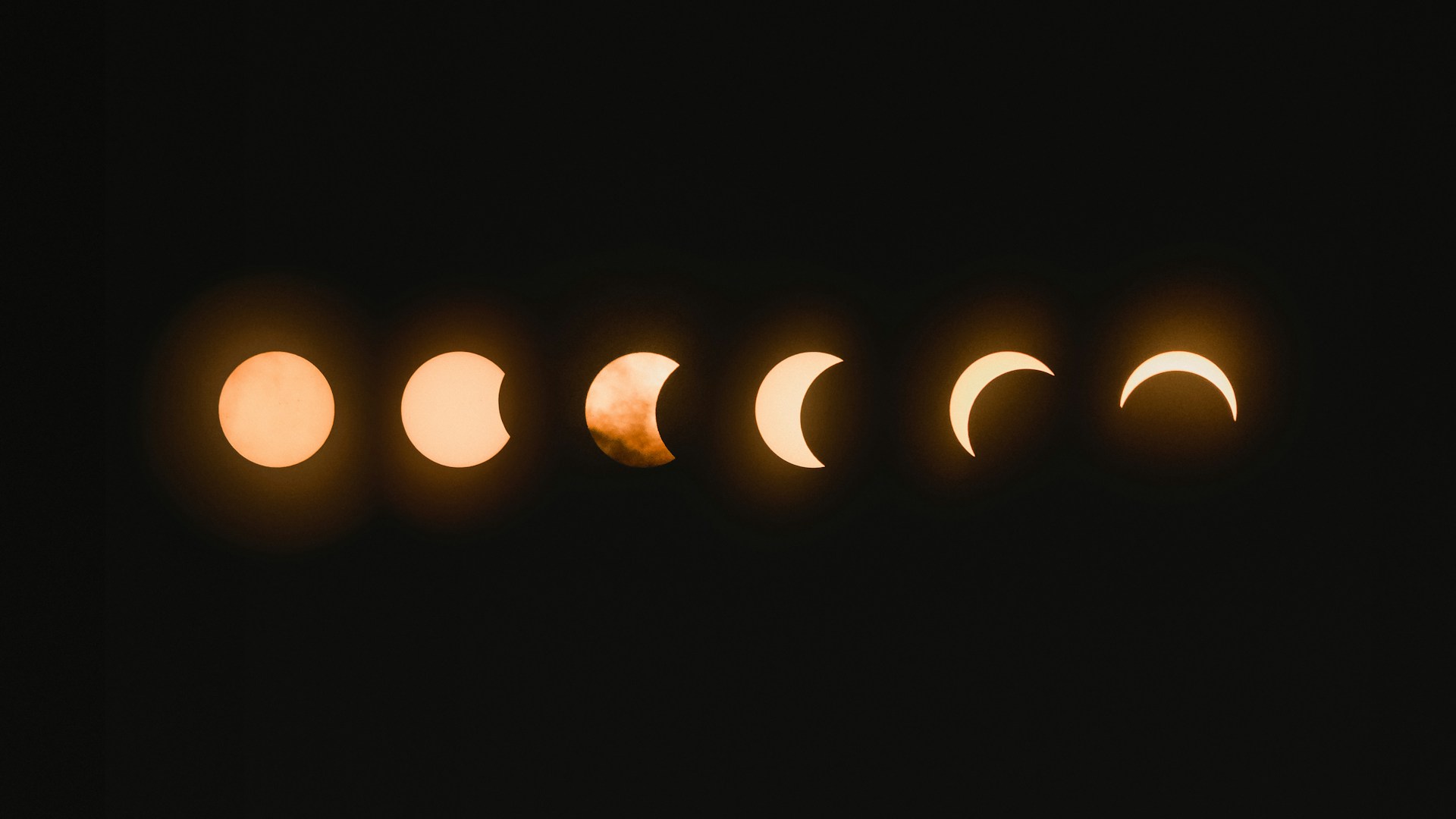Awakening the Divine Within
Across time and across cultures, the Goddess has been revered as the eternal principle of life. She is the one who births, sustains, and dissolves; who protects, nurtures, and transforms. Her presence can be found in the cycles of nature, in the turning of the seasons, in the waxing and waning of the moon, and in the inner landscape of our own being.
Though the languages, rituals, and names differ, her faces and forms numerous—from the Vedic – Durga, Kali, Saraswati, Lakshmi, the Egyptian, Greek Goddesses to the Celtic and Pagan- Brigid, Danu, the Triple Moon Goddess, to name only a few. Her forms and energies she symbolises are numerous and varied —yet her essence is one: the eternal feminine principle of life, creation, sustainer, transformation, and renewal.
She is not something separate from us, but a reminder of the rhythms we are already part of.
Today, in a world that often pulls us away from natural cycles and inner stillness, returning to these ancient understandings can feel like a homecoming.
This is something I have been reflecting on and feeling so connected with recently following my "Awaken the Goddess Within" Shakti sadhana program for Navaratri (in the ancient Vedic tradition of India) – which inspired me to write and share this article.
The Goddess in Vedic Tradition & Navaratri
In the Vedic worldview, the Goddess is Shakti—pure creative energy, without which even the gods are powerless. She manifests as Durga, the invincible one; as Lakshmi, the bringer of abundance; as Saraswati, the river of wisdom; as Kali, fierce liberator of the primordial energy from which all forms arise.
Navaratri, the "nine nights of the Goddess," is one of the most profound celebrations of this divine feminine force. It is more than ritual—it is sadhana (a spiritual practice), a practice of turning inward. Each night invites us to reflect on qualities of the soul.
Navaratri aligns with the turning of the seasonal wheel— most recently the shift into autumn. It is a time when nature itself begins her descent, a reminder of impermanence and the cycles of life, death, and rebirth. Just as the Gunas (Sattva – clarity, Rajas – activity, Tamas – rest and dissolution) move through constant interplay, we too are invited to balance stillness, activity, and rest in our own lives. Navaratri is not only an outer celebration but is known as an energetically powerful and potent time for inner sadhana (spiritual practice) and aligning with the deeper rhythm of the cosmos.
So we celebrate Navaratri at each seasonal turning point (spring / autumn equinox and summer / winter solstice's) in the Vedic calendar, where we honour this power through nine nights of devotion, ritual, and inner reflection. Each Goddess worshipped in different forms over these nights represents qualities within ourselves, such as courage, abundance, wisdom, and the fierce strength to dissolve what is no longer needed.
These teachings see the Goddess not as distant archetypes, but as living energies within ourselves. Her courage is our courage. Her wisdom is our wisdom. Her fierce clarity is our own ability to cut through illusion.
The Goddess in Celtic Traditions
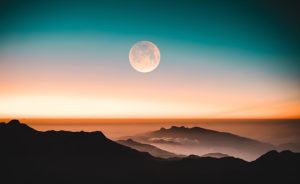
Photo by malith d karunarathne on Unsplash
Far from India, yet strikingly similar in spirit, Celtic cultures held the Goddess at the centre of life and land. She was seen in the rivers, wells, and mountains; in the fertility of the soil and the cycles of the sun and moon – in all of nature itself.
The Triple Moon Goddess—maiden, mother, and crone (or wise woman / sage as I prefer to say!)—echoes the same truth as the Vedic trinity of creation, preservation, and dissolution. She represents the phases of life, the waxing and waning of the moon, and the eternal rhythm of growth, fullness, and release. Goddesses such as Brigid (keeper of fire, poetry, and healing) and Danu (the flowing river of wisdom) were revered not only as mythic figures but as living presences woven into daily existence.
In these traditions, festivals marked seasonal transitions—the equinoxes, solstices, and harvest times. Just like Navaratri, they were moments to pause, honour change, and realign with the wheel of life.
In some traditions, we also recognise a fourth phase of the Goddess — the Wild Woman — completing the sacred circle of the feminine journey. Together, the Maiden, Mother, Wild Woman, and Crone/Sage embody the full expression of womanhood and reflect the cyclical nature of both life and creation itself. These four aspects mirror the four main seasons of the Celtic wheel of the year, the phases of the moon, and the rhythms of a woman's own body — reminding us that we are intimately connected with the pulse of the Earth and cosmos.
The Maiden corresponds with the waxing moon and the spring season — a time of renewal, growth, and possibility. In a woman's menstrual cycle, this reflects the pre-ovulatory or follicular phase, when energy rises and creativity blossoms.
The Mother aligns with the full moon and summer, symbolising fertility, abundance, and outward expression — the time of ovulation and peak vitality.
The Wild Woman, often overlooked in modern depictions, corresponds to late summer and early autumn, and the luteal phase of the cycle — a time of integration, discernment, and turning inward to harvest the wisdom gained. She is also often linked to the creative, untamed, and authentic self, particularly before the menstrual period and the perimenopausal phase.
Finally, the Crone/Sage embodies the waning to dark moon and the winter season — mirrored in the menstrual phase of her cycle, when the body sheds, rests, and renews itself in preparation for the next cycle. As well as the phase of menopause and beyond.
Each phase offers its own gifts and teachings, inviting us to live in tune with the ebb and flow of our natural energy rather than resisting it. When we honour these rhythms — within our bodies, our emotions, and the cycles of nature — we cultivate a deeper sense of balance, self-acceptance, and harmony with life's ever-turning wheel.
The Wheel of Life: Cycles Within & Without
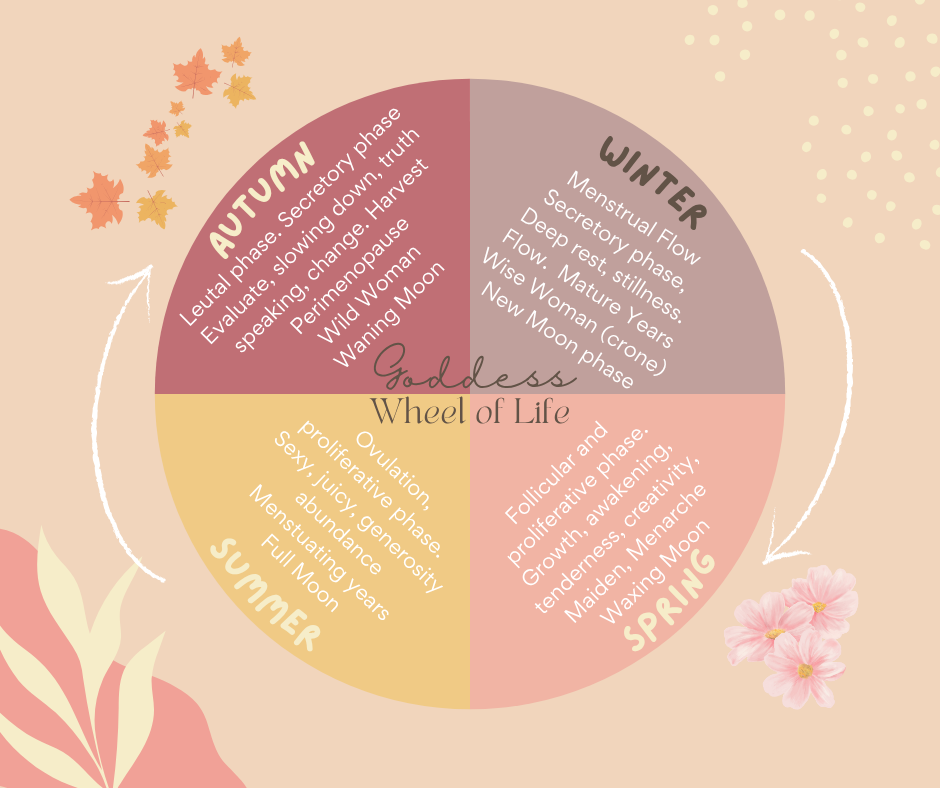
What unites these traditions is the recognition that the Goddess is cyclical. She is not fixed or static, but ever-changing—just as we are. Her many faces mirror the stages of our own lives: youth, growth, maturity, decline, renewal.
The wheel of the year in Celtic culture and the cycles of Navaratri both remind us that we are part of a larger whole. To honour the Goddess is to honour these cycles, rather than resisting them.
This wisdom is deeply healing in modern times, where we often push against natural rhythms—ignoring rest, fearing endings, and clinging to constant productivity. By reconnecting with the Goddess, we learn to value rest as much as growth, endings as much as beginnings.
Symbolism of the Goddess
The Goddess in her many forms speaks to us through rich and universal symbols:
-
The Moon – representing intuition, reflection, and the dance between light and darkness. The phases of the moon – reflecting the phases of a woman's menstrual cycle.
-
The Seasons – symbols of growth, fruition, decay, and renewal, mirroring our own inner phases.
-
The Gunas – the qualities of stillness, activity, and inertia that weave together all of existence.
-
The Triple Form – maiden, mother, crone; creation, preservation, destruction; morning, noon, night.
-
The nine nights of Navaratri – The sacred number 9. The 9 months of gestation and the 9 nights for Shakti's energy to unfold./ Three trimesters relating to the 3 gunas and completing with "rebirth".
These symbols are not only cosmic but intimate—they reflect the workings of our own body, mind, and spirit.
The Goddess Within
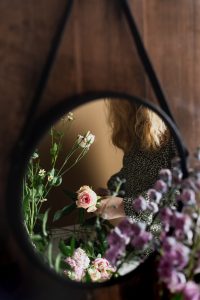
Photo by micheile henderson on Unsplash
Perhaps the most profound teaching across cultures is this: the Goddess is not something we must seek outside of ourselves. She lives within each of us—as intuition, as creativity, as strength, as compassion.
When we chant to Durga, we awaken courage in our own hearts. When we honour Brigid, we kindle the flame of inspiration within. When we observe the moon's cycle, we reconnect with the ebb and flow of our own energy.
This is not worship in the sense of distance, or something outside of ourselves, but in remembrance. A remembrance that we are not separate from nature, from the cosmos, from the eternal rhythms of life. The Goddess is not "other" but a reflection of who we truly are.
Living in Rhythm
To walk the path of the Goddess is to live in rhythm—with the breath, the seasons, the moon, the rise and fall of life's tides. It is to embody balance, resilience, and harmony.
We do this not through elaborate rituals alone, but through daily acts of connection: pausing at sunrise to give gratitude, lighting a candle at dusk, walking barefoot on the earth, honouring our body's need for rest, creating space for reflection. These are simple yet profound ways to realign with the cycles that sustain us.
Closing Reflection

Photo by Ahmad Odeh on Unsplash
The Goddess in all her forms invites us back to wholeness. Whether we meet her as any one of her many forms, she reminds us of the eternal dance of creation and dissolution, light and shadow, growth and rest.
In remembering her, we remember ourselves.
May you find the Goddess not only in stories of the past, but in the turning of the seasons, the rhythm of your breath, and the wisdom of your own heart.
Reflective Practice: Awakening the Goddess Within

Photo by Sixteen Miles Out on Unsplash
To deepen your connection with this ancient wisdom — and to awaken the living Goddess within — take a few quiet moments for personal reflection. The following gentle practice and journaling prompts can help you tune into your own inner rhythms and hear the whispers of the divine feminine moving through your life.
Take a few quiet moments for yourself. Light a candle or sit by a window where you can see the sky. Close your eyes and bring awareness to your breath — the natural rhythm of inhalation and exhalation, rising and falling like the tides of life.
As you settle into stillness, place one hand on your heart and one on your womb or lower belly — the centres of intuition, creation, and deep feminine wisdom. Breathe into these spaces, inviting a sense of softness, grounding, and connection.
Ask inwardly:
"Which aspect of the Goddess am I being called to embody right now?"
"Where in my life am I being asked to release, to nourish, or to create anew?"
After a few minutes, open your eyes and reflect in your journal. You might explore:
Journaling Prompts

Photo by Priscilla Du Preez 🇨🇦 on Unsplash
- How do I experience the Goddess energy within me — in my intuition, my strength, my creativity, or my compassion?
- What natural cycles or rhythms do I feel most connected to — the moon, the seasons, the flow of my own energy?
- What phase am I currently moving through in my own "inner wheel of life"? (growth, abundance, letting go, renewal…)
- Which qualities of the Goddess — courage, wisdom, nurturing, transformation — are calling for more expression in my life?
- How can I honour the Goddess within me each day in small, meaningful ways?
Close your reflection with gratitude — for the divine feminine energy that moves through you, and for the reminder that you are never separate from the sacred cycles of life.
Main – Photo by Mark Tegethoff on Unsplash
